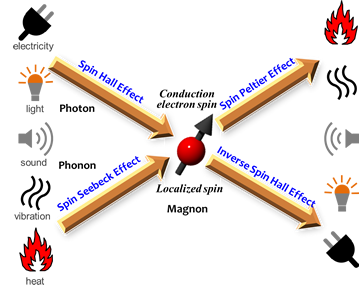
![]()
【Purpose of the Research Project】
Spin conversion is a generic term for all the conversion phenomena based on the principle of angular momentum conservation, including recently discovered phenomena, i.e. the spin Hall effect, the inverse spin Hall effect, the spin Seebeck effect, the spin Peltier effect, the pure spin current induced magnetic switching, the spin injection into insulators, the electric field controlled magnetic anisotropy in ultra-thin ferromagnetic films, and so on.

Most of the above mentioned spin conversion phenomena take place at simple nano-scale interfaces between two different materials of magnets, non-magnets, semiconductors, or insulators. So that spin conversion phenomena are versatile for designing device functionalities in spintronic applications. However for further advancement in the spin-conversion science, microscopic understanding in terms of inter-conversions among particles and quasi- particles, such as, itinerant spins, magnons, phonons and photons is indispensable.
The goal of this research area “Nano Spin Conversion Science” is thus to establish unified understanding of the above mentioned spin conversion phenomena from both experimental and theoretical viewpoints. Thereby this research activity will create a new research field associated with spintronics, and will finally strengthen the presence of Japan as a world leading country in the research field of spintronics.
【Content of the Research Project】
In order achieve objectives, a variety of spin conversion properties will be investigated using following 4 experimental modalities: 1) magnetic spin conversion; 2) electrical spin conversion; 3) optical spin conversion; 4) thermodynamic spin conversion, and 5) theoretical design of spin conversion functions.
More precisely, 3 objectives are set as follows;
(1) Creation of new spin conversion properties by elucidating the responsible physics for magnetic, electronic, optical, and thermo-dynamic spin-conversions occurring at the interface junctions of different materials.
(2) Establishment of non-linear spin conversion technology unlike conventional linear spin conversion.
(3) Construction of the unified spin-conversion science that explains various interconversions among quasi-particles, e.g. magnons, phonons, and photons, taking place in magnetic, semiconducting, and insulating materials.
(1) Creation of new spin conversion properties by elucidating the responsible physics for magnetic, electronic, optical, and thermo-dynamic spin-conversions occurring at the interface junctions of different materials.
(2) Establishment of non-linear spin conversion technology unlike conventional linear spin conversion.
(3) Construction of the unified spin-conversion science that explains various interconversions among quasi-particles, e.g. magnons, phonons, and photons, taking place in magnetic, semiconducting, and insulating materials.
【Expected Research Achievements and Scientific Significance】
The spin conversion science itself is an important subject to be clarified in modern solid state physics, in terms of angular momentum and energy transfer between various solids. Pursuing this research will lead to development of new experimental methods as well as discovery of novel spin conversion mechanisms. Most importantly all the achievements that made in the project will qualitatively elevate the level of Japanese solid state physics.
【Key Words】
Spin currents, spin orbit interaction, spin Hall effects

